用JPA和Spring管理数据
MyEclipse 3.15 Style——在线购买低至75折!火爆开抢>>
【 MyEclipse最新版下载 】
本教程介绍了MyEclipse中的一些基于JPA / Spring的功能。有关设置JPA项目的基础知识,请先阅读 JPA教程 。 本教程主要关注MyEclipse中的JPA-Spring集成以及如何利用这些函数。您将学习到:
- 为JPA和Spring建立一个项目
- 反向设计一个数据库表来生成实体
- 实现创建,检索,编辑和删除功能
- 启用容器管理的事务
持续时间:30分钟
没有MyEclipse?现在下载
一、使用JPA和Spring Facets创建一个Java项目
将JPA和Spring功能添加到Java或Web项目中是最常见的。 本教程使用Java项目来演示这些技术是如何工作的。
注意:您可以下载本教程中开发的项目,然后导入到工作区中。
1. 创建一个名为SampleJPASpringProject的示例Java项目,并向其 添加JPA facet 。
2. 右键单击该项目,然后选择MyEclipse>Project Facets>Install Spring Facet。
3. 单击Next接受Spring版本和runtime默认值。
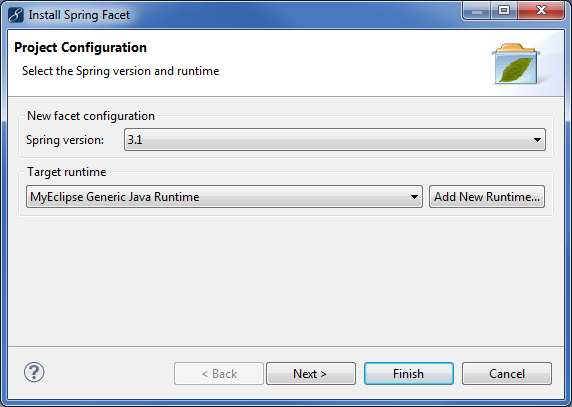
设置Spring版本和目标运行时
4. MyEclipse创建一个新的 applicationContext.xml 文件夹,然后单击Next。
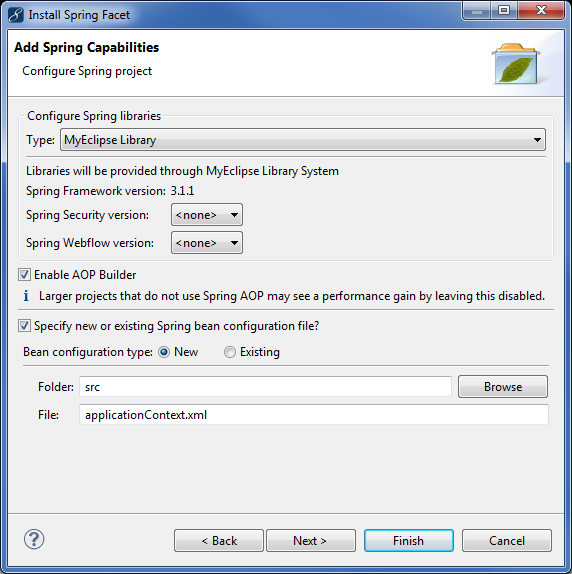
设置bean配置
5. 注意Add Spring-JPA support复选框,它指示MyEclipse在这个JPA项目中生成源,将Spring和JPA集成在一起。 因为您将Spring添加到JPA项目,所以默认情况下会选择此项。 此外默认情况下,支持使用@Transactional Spring注释。单击Finish。

添加Spring-JPA功能
注意: Spring Container-Managed Transactions 部分介绍了基于注释的事务支持。
既然该项目已添加了JPA和Spring facets,则可以打开 applicationContext.xml Spring bean配置文件,并查看项目是如何配置的。 通过单击编辑器底部的Beans Graph选项打开图形视图。
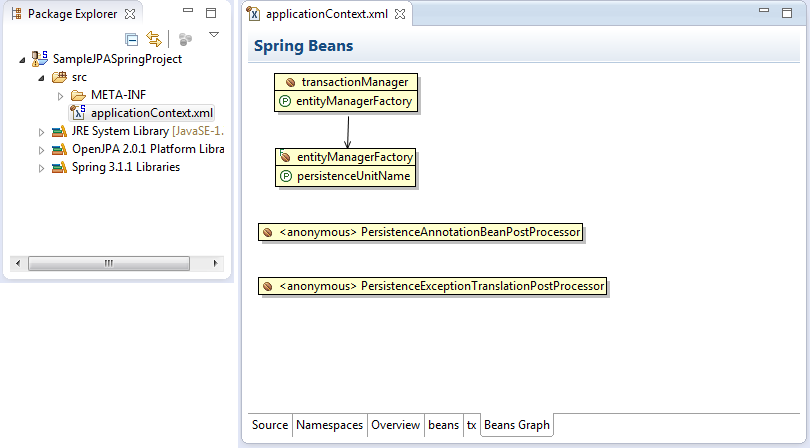
Spring配置
你可以从Spring bean配置文件中看到不同的bean是如何配置的。 transactionManager使用entitytManagerFactory,后者依次使用JPA持久性单元(在添加JPA facets时创建的)。
二、逆向工程
现在已经建立了项目,您已经准备好将PRODUCTLINE表逆向工程,并开始使用生成的实体。
1. 右键单击src文件夹,然后选择New>Package创建一个用于生成实体的包。
2. 右键单击该包,然后选择MyEclipse>Generate Entities & DAOs。
3. 选择PRODUCTLINE,单击Add,然后单击Next。
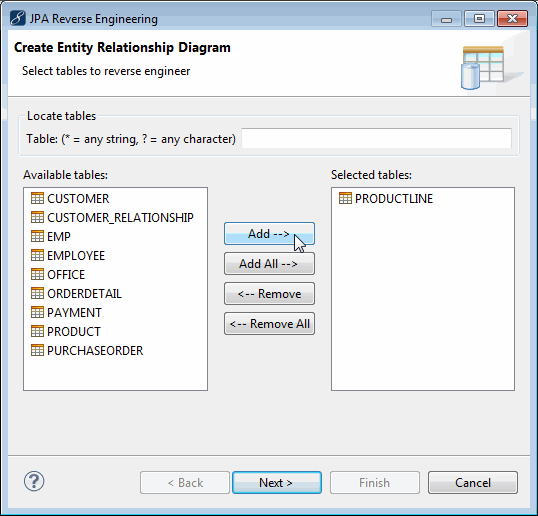
选择 PRODUCTLINE 表
4. 填写如下所述的字段。
Java source folder:生成文件的项目文件夹
Java package:您在上面创建的包中放置生成的类的包
Entity Bean Generation:告诉MyEclipse生成的正确标注为用作JPA实体的普通Java类
Create abstract class:如果您想自定义生成的类,而不是每次都覆盖修改,MyEclipse可以生成基本的抽象类以及您可以自定义和使用具体的子类。每次逆向工程时,MyEclipse只覆盖抽象基类,在具体子类中维护您的修改。
Update persistence.xml:与Hibernate类似,您可以列出您在JPA配置文件中使用的所有JPA实体。
Java Data Access Generation:告诉MyEclipse生成DAO实用程序类,使您可以立即保存/查找/更新/删除数据库中的实体。 这段代码包装了JPA实体管理器,使得使用实体和数据库非常容易。
Generate Precise findBy Methods:告诉MyEclipse生成findByXXX方法,其中XXX属于相反实体上的每个属性。 这使得可以使用任何属性轻松访问数据库中的实体,以此作为找到它们的手段。
Generate Java interfaces:告诉MyEclipse生成顶层的DAO接口以及具体的实现(例如IProductlineDAO和ProductlineDAO)
DAO Type:根据生成的DAO的类型,MyEclipse(除了为您生成DAO实现)还可以使用挂接到现有entityManagerFactory的新DAO更新您的Spring bean配置文件。
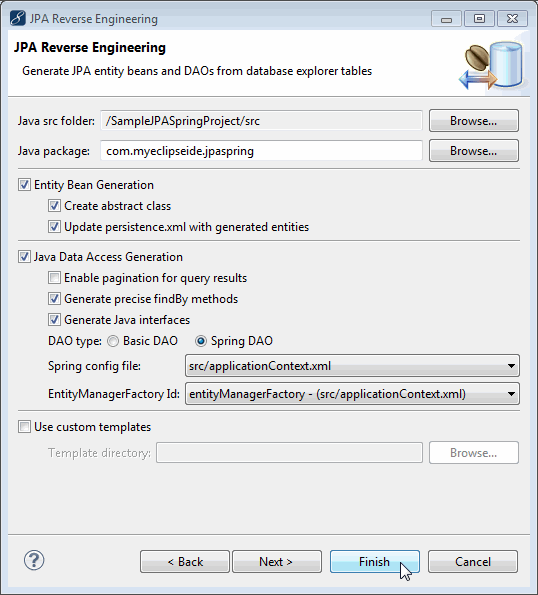
生成实体
5. 单击Finish完成reverse-engineer表。当逆向工程完成后,您可以再次查看项目的Spring配置并查看更新。
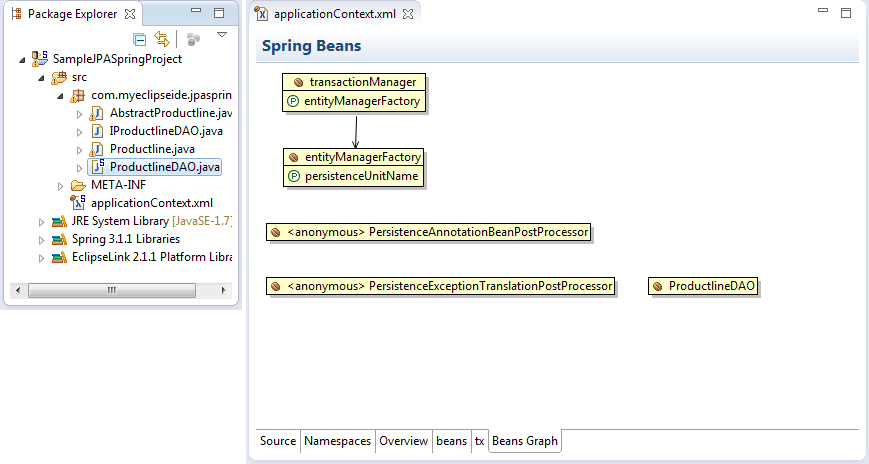
新的Spring DAO
使用更新的Spring视图,您可以看到包含的ProductlineDAO。
三、写一个应用程序
现在MyEclipse已经生成了所有这些代码,您可以快速地编写您的业务逻辑。
JPA教程 涵盖了实体和DAO类所做的每个操作以及运行简单场景的主要方法基本概述,其中包括:
- 创建一个新的实体并将其插入到数据库中
- 检索实体
- 更新实体
- 删除实体
同样,在本教程中,您将看到如何使用Spring获取和使用DAO以及管理事务。这个演示的起点是RunJPA.java类,看看这个类的主要方法。
<strong>/* 1. Initialize the transactionManager and DAO */</strong>
ClassPathXmlApplicationContext ctx = new ClassPathXmlApplicationContext("/applicationContext.xml");
txManager = ((JpaTransactionManager) ctx.getBean("transactionManager"));
dao = ProductlineDAO.getFromApplicationContext(ctx);
<strong>/* 2. Create a reference to our ID */</strong>
String productlineID = "Men Shoes";
<strong>/* 3. Save a new productline to the DB */</strong>
saveProductline(productlineID);
<strong>/* 4. Load the productline from DB to make sure it worked */</strong>
loadProductline(productlineID);
<strong>/* 5. Update the productline in the DB and check it */</strong>
updateProductline(productlineID);
<strong>/* 6. Delete the productline from the DB */</strong>
deleteProductline(productlineID);
以蓝色标记的代码部分是Spring调用,您可以从bean配置中检索已配置的bean。 请注意,由于您正在手动管理事务,因此还可以从bean配置中检索transactionManager。
其余的项目#2 - #6简单地调用每个 “do something”的方法。
3.1 保存一个实体
第一个有趣的方法是saveProductline,此方法的目的是创建一个新的实体并将其存储在数据库中。
<strong>/* 1. Create a new Productline instance */
</strong>Productline newProductline = new Productline(productlineID,
"Shoes formen.", "<strong>MenShoes</strong>", null);
<strong>/* 2. Store our new product line in the DB */</strong>
TransactionStatus status = txManager
.getTransaction(new DefaultTransactionDefinition());
dao.save(newProductline); txManager.commit(status);
首先,使用一些基本值创建新的Productline实例。 其次,使用transactionManager,事务在将实体保存到数据库之前就开始了。 保存实体后,事务被提交。
手动管理事务的目的是因为作为开发人员,您知道“保存”操作的范围。根据应用程序的编写方式,一些操作可以包含许多DB修改。 把这些全部包装在一个单独的交易中是非常重要的,以防万一中途失败。
3.2 检索一个实体
下一个方法使用分配给它的ID从DB中检索实体,并显示其值; 这证实了保存操作的工作。
<strong>/* 1. Now retrieve the new product line, using the ID we created */</strong>
Productline loadedProductline = dao.findById(productlineID);
<strong>/* 2. Print out the product line information */</strong>
System.out.println("*NEW* Product Line [productLine="
+ loadedProductline.getProductline() + ", textDescription="
+ loadedProductline.getTextdescription() + "]");
注意在这个代码中,没有使用事务。 原因是这个代码只执行一个读操作而不是一个写操作。 即使操作失败,也不会影响数据库中的数据。 所以,没有必要保护使用交易的操作。
3.3 更新实体
现在代码的下一部分可能看起来更长,但这是因为会打印出新的值,并确认记录已在数据库中更新。
/* 1. Now retrieve the new product line, using the ID we created */
Productline loadedProductline = dao.findById(productlineID);
/*
* 2. Now let's change same value on the product line, and save the
* change
*/
loadedProductline.setTextdescription("Product line for men's shoes.");
TransactionStatus status = txManager .getTransaction(new DefaultTransactionDefinition());
dao.update(loadedProductline);
txManager.commit(status);
/* * 3. Now let's load the product line from the DB again, and make sure
* its text description changed
*/
Productline secondLoadedProductline = dao.findById(productlineID);
System.out.println("*REVISED* Product Line [" + "productLine="
+ secondLoadedProductline.getProductline()
+ ", textDescription="
+ secondLoadedProductline.getTextdescription() + "]");
注意update调用是用一个事务封装的,因为它必须向数据库写入一些东西,并且需要防止失败。
在上面的第3节中,产品线在更新后立即从数据库加载,并打印出从数据库返回的值以确认更新。
3.4 删除一个实体
删除实体与保存和更新实体几乎相同。 工作被封装在一个交易中,然后DAO被告知要做这项工作。
/* 1. Now retrieve the new product line, using the ID we created */
TransactionStatus status = txManager
.getTransaction(new DefaultTransactionDefinition());
Productline loadedProductline = dao.findById(productlineID);
/* 2. Now let's delete the product line from the DB */
dao.delete(loadedProductline);
txManager.commit(status);
/*
* 3. To confirm the deletion, try and load it again and make sure it
* fails
*/
Productline deletedProductline = dao.findById(productlineID);
/*
* 4. We use a simple inline IF clause to test for null and print
* SUCCESSFUL/FAILED
*/
System.out.println("Productline deletion: "
+ (deletedProductline == null ? "SUCCESSFUL" : "FAILED"));
与上面的updateProductline实现类似,您会注意到事务用于包装删除调用,然后代码尝试从DB加载实体并确认操作失败。
注意:事务必须封装findById和delete方法调用的原因是因为由JPA管理的对象必须是同一个事务的一部分。 要删除加载的对象,它必须在它被加载的同一个事务中,试图将其删除。
3.5 运行程序
运行它的输出如下所示:
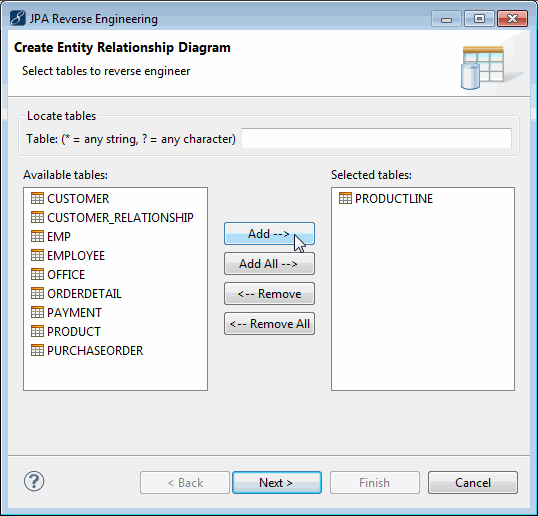
输出
红色文本是可以忽略的默认日志消息(如果要控制日志记录,可以设置自定义log4j.properties文件)。 在日志警告的下面,您会看到两条来自TopLink(JPA实现库)的消息,然后是三条消息全部来自实现。
第一条消息打印出已添加的新产品线信息,第二条更新消息并打印新信息,最后一条消息从数据库中删除并打印确认消息。
四、启用Spring容器管理事务
除了用户管理事务外,Spring还通过@Transactional属性支持容器管理事务。 对于容器管理的事务支持,当您添加facets时,必须启用它,在前面的部分已经介绍过。
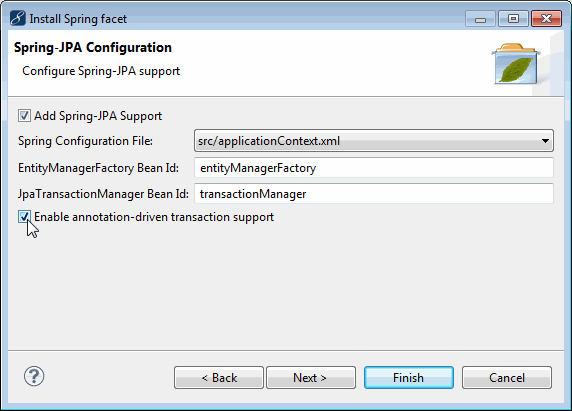
启用对@Transactional注释的支持
启用它会将以下事务元素添加到您的bean配置文件中。 您还应该添加一个JPAServiceBean,它用于删除使用容器管理的事务实体。 请参阅下面的实现:
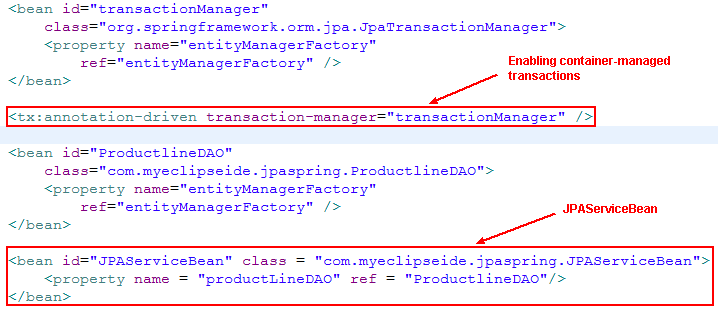
注释驱动的配置元素
JPAServiceBean实现如下所示;请注意deleteProductLine方法上的@Transactional注释以及缺少任何用户管理的事务语句。
public class JPAServiceBean {
private IProductlineDAO dao; @Transactional public void deleteProductLine(String productlineID) { /* 1. Now retrieve the new product line, using the ID we created */Productline loadedProductline = dao.findById(productlineID); /* 2. Now let's delete the product line from the DB */ dao.delete(loadedProductline); /* * 3. To confirm the deletion, try and load it again and make sure it * fails */
Productline deletedProductline = dao.findById(productlineID);
/* * 4. We use a simple inline IF clause to test for null and print * SUCCESSFUL/FAILED */
System.out.println("Productline deletion: " + (deletedProductline == null ? "SUCCESSFUL" : "FAILED"));} public void setProductLineDAO(IProductlineDAO dao) { this.dao = dao; }
}
从应用程序上下文中获取JPAServiceBean的一个实例并按如下所示使用它:
JPAServiceBean bean = (JPAServiceBean) ctx.getBean("JPAServiceBean");
bean.deleteProductLine(productlineID);
更多资讯敬请访问MyEclipse中文网>>
- 本文标签: classpath http description Service 管理 spring集成 JPA map MQ CTO web entity find Action NSA value eclipse 下载 cat IO 注释 update src Persistence 数据 XML myeclipse ACE 产品 ORM 时间 java Java类 https EntityManagerFactory UI 实例 db 删除 数据库 bean 代码 spring 开发 ip JPA实体 配置 id App
- 版权声明: 本文为互联网转载文章,出处已在文章中说明(部分除外)。如果侵权,请联系本站长删除,谢谢。
- 本文海报: 生成海报一 生成海报二










![[HBLOG]公众号](https://www.liuhaihua.cn/img/qrcode_gzh.jpg)

